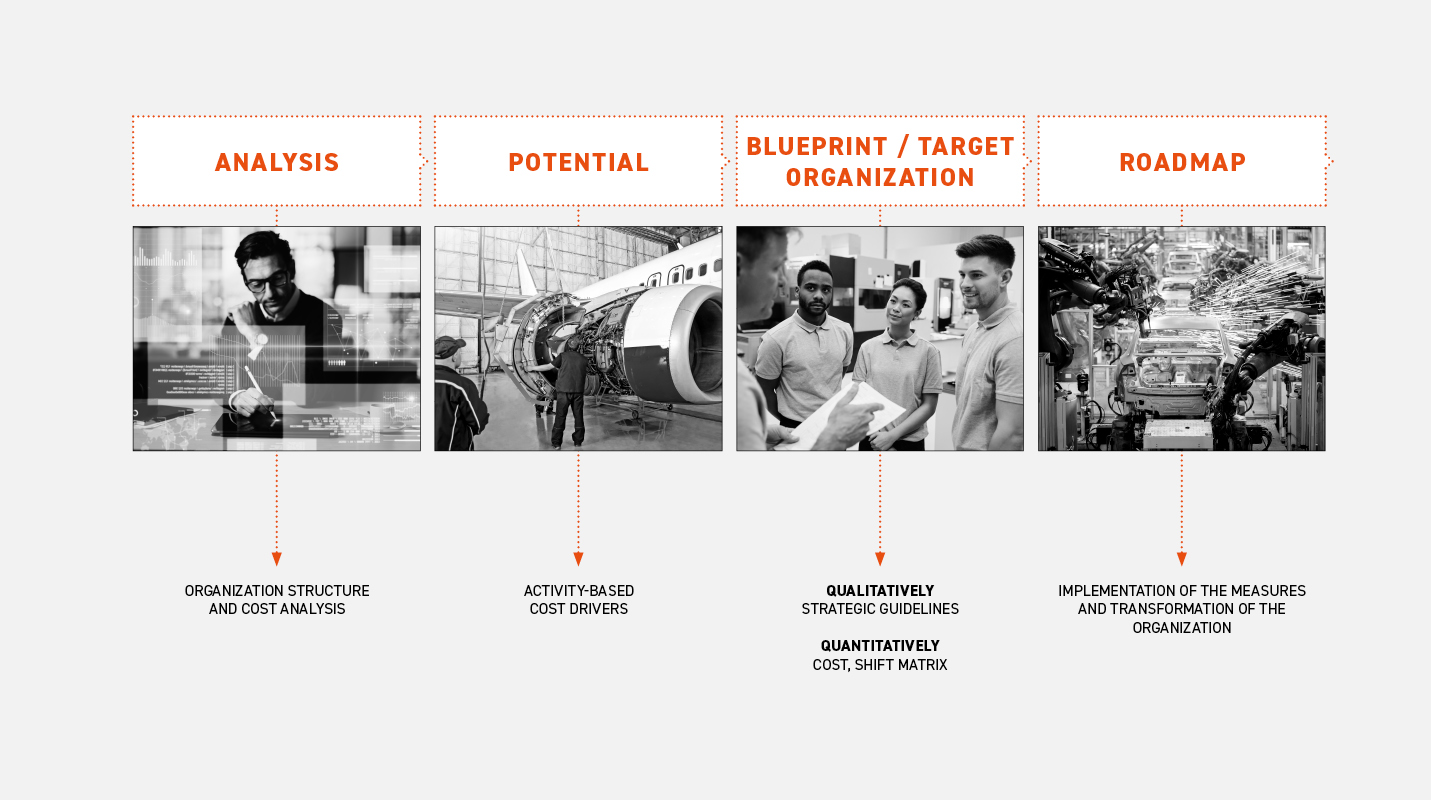ZERO-BASED ORGANIZATION
NORTH STAR FOR THE GLOBAL ORGANIZATION
SUCCESSFULLY STREAMLINING INDIRECT AREAS WITH ROI ‘S ZERO-BASED APPROACH.
Champions do not rest on their laurels, but always keep an eye on the next stage goal. A technology group, whose approximately 20,000 employees at more than 16 locations worldwide already generate a turnover of more than two billion euros, also oriented itself towards such a „North Star“. Its starting points: an operations strategy and the initiatives derived from it, which should be implemented at every location in order to make it even more efficient. In addition to the OPEX topics, the company, together with ROI, realigned the organization of all production sites according to the „zero-based organization“ approach.
Anyone who manages highly heterogeneous manufacturing networks with different languages, work processes and (organizational) cultures is constantly on the lookout for standardization and potential for improvement: Why don’t locations achieve their efficiency targets even though classical productivity is extremely high? Are there too many or too few indirect employees? How can the organization be adapted to the processes optimally? And how can management control and steer this at more than ten locations without having to put themselves in each organization’s shoes each time all over again? The technology group was also confronted with precisely these challenges. For its “zero-based” project, it therefore pursued very concrete objectives: in the end, not only should the status quo of the organization be clearly mapped, but also the future, ideal setup for all locations should be defined. Already on the way there, it became apparent that 41% of the potential could be converted into coordinated measures and actual savings.
ROI ZERO-BASED APPROACH
Together with ROI, the company identified the gaps between the status quo and the future ideal of the “zero based north star”. Using ROI’s own zero-based approach, the project team was able to develop a standardized, scalable and more efficient organization step by step. Four project phases are p a r t i c u l a r l y important this way: the analysis of the activity structure on the basis of the ROI activity catalogue, the determination of potential, the development of a Blueprint of the organization including dimensioning as well as the approach to implementation (Roadmap).
ANALYZE STRUCTURES
How many capacities flow into direct activities today, how many into indirect activities? ROI follows a strict definition: Only activities that are reflected in the production times (te and tr) are directly value-adding. All other activities are indirect, including logistics, quality assurance and maintenance. Transparency is the key to the overall success of the initiative: Who really does what? This is because department allocations do not say anything about the actual activities. Is maintenance now responsible for machines and buildings or only for machines?
In the first phase of the project, the team concentrates primarily on the current activity and organizational structure. It assigns 100% of the working time of all employees to specific, predefined activities. ROI brings with it a proven catalogue of activities, which usually covers 95% with around 100 activities. The rest is completed customer-specific.
DETERMINE POTENTIALS
The activity structure must now be interpreted correctly. Where are signs of potential, where does the organization already appear lean? First of all, benchmarks are very helpful, which the project team devotes itself to in the next phase: in internal benchmarks, it compares the same activities across several plants and departments of the company. This is extended with an external perspective, i.e. with industry and function benchmarks that use empirical values and best practices from over 20 years of ROI project experience. And: benchmarks must always take into account the nature of the business (e.g. mass production vs. individual orders).
It is not enough just to determine the potential, but it must also be possible to explain it to the employees via improvement levers in the process, organization or service portfolio - for example, the benchmark in order processing shows greater potential. At the same time, there are many interfaces in the process, duplicate tasks and poorly used IT systems are identified. According to ROI experience, 80% of the cost reduction potentials refer to inefficient processes, about 20% can be tapped through purely organizational changes.
CREATE BLUEPRINT AND DIMENSION TARGET ORGANIZATION
The following project sections focus on how these potentials can now be activated in practice. Here the project team “designs” the ideal organizational structure. To this end, it defines design guidelines (e.g. number of management levels and management ranges), determines the right level of central and decentralised functions and determines the optimal dimension of the organization. At the end the Blueprint organization is summarized in a standardized and scalable organizational structure.
IMPLEMENT TARGET ORGANIZATION
Once this objective has been clarified, the “how” follows the implementation. Depending on the location, for example, a works council must be involved or country-specific requirements must be observed - this makes individual transformation paths necessary. With ROI, the technology group also developed its own concept for the implementation of each location - with the path from the current state to a target image that comes very close to the “zero-based north star”. With two years, the company calculated a realistic time frame from project start to roll-out in all locations. A decisive success factor in the implementation was working with the plant managers on site.

